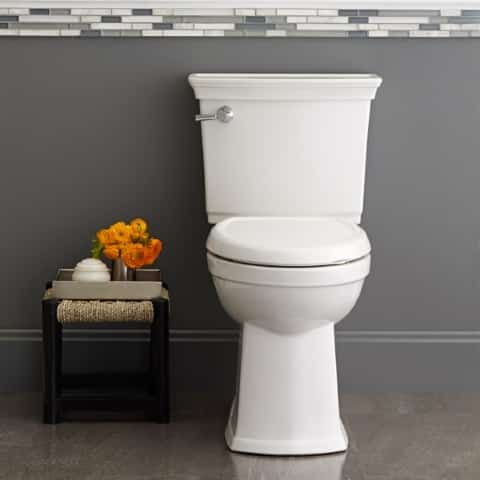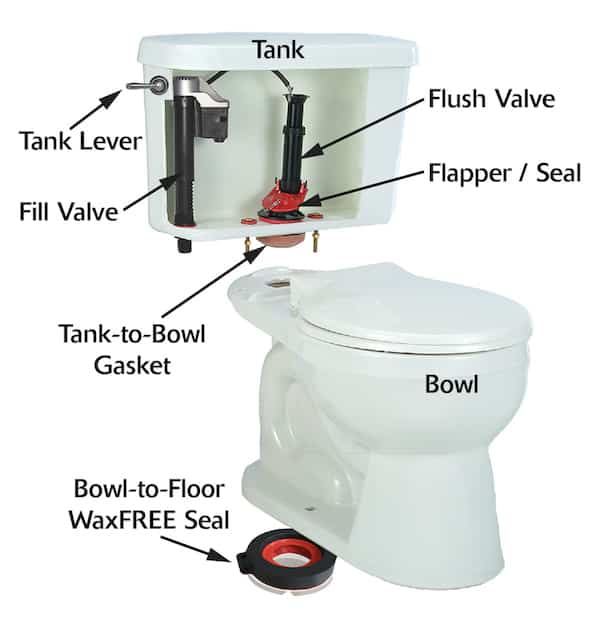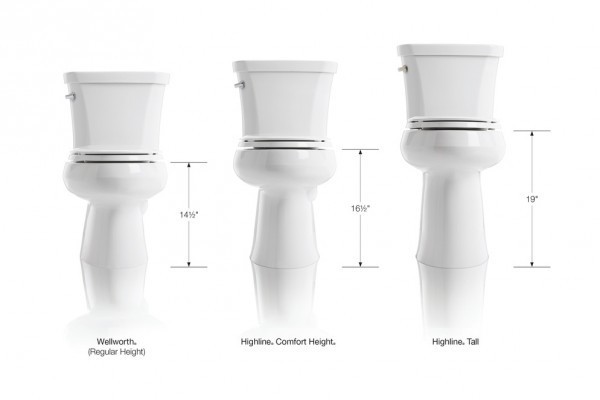Home » Blog » Why Is My Toilet Leaking?

How To Fix A Leaking Toilet.
This webpage will guide you through common causes and solutions for internal toilet leaks. Left unchecked, toilet leaks can waste water, damage your floors, and even lead to mold growth. Here are some additional things to keep in mind when repairing a toilet:
- Safety first: Always turn off the water supply to the toilet before starting any repairs.
- Consider calling a plumber: If you're not comfortable doing the repairs yourself, or if the leak seems complex, it's best to call a professional plumber at PDM.
- Tools you'll need: Depending on the repair, you may need a wrench, screwdriver, bucket, sponge, replacement parts (flapper, fill valve, wax ring, etc.)
By following this guide and using a little common sense, you should be able to fix most common toilet leaks yourself. But if you're ever in doubt, don't hesitate to call a plumber.

1. Leaking Toilet Flapper Water Seal.
-
Flapper seal problems can lead to a constantly running fill valve: While it might seem like the fill valve itself is malfunctioning, a faulty flapper is often the culprit.
-
Flapper wear and tear: Toilet flappers are prone to wearing out after a few years due to constant use.
-
Signs of a failing flapper:
- Physical condition: Cracks, brittleness, mineral deposits
- Discoloration: If the flapper transfers color to your fingers upon touch, it's deteriorating.
-
Flapper as a symptom: In some cases, a malfunctioning flapper can be caused by a sticky handle or an improperly adjusted flapper chain. Learn how to replace your leaky toilet flapper.
2. How to Troubleshoot a Toilet That's Running Constantly Due to a High Float.
1. Inspect the Float:
- Look for the float ball or cup inside the toilet tank.
2. Identify the Float Type:
- There are two main types:
- Float ball: This is a ball attached to an arm.
- Cup float: This is a cup-shaped piece that slides on a vertical tube.
3. Adjust the Float Level:
- For ball floats: Carefully bend the arm to lower the ball.
- For cup floats: Locate the adjustment mechanism (often a pinch clamp) and slide the cup down the tube.
4. Test and Monitor:
- Flush the toilet and observe the water level. It should be about an inch below the overflow pipe.
- If the problem persists, there might be an issue with the fill valve itself.
5. Replacing the Fill Valve:
- If adjusting the float doesn't work, consider replacing the entire fill valve as it might be faulty.
By following these steps, you should be able to fix a running toilet caused by a high float.
3. Toilet Fill Valve Leaking? How to Fix a Running Toilet.
Turn off the water supply valve located behind the toilet. If the valve does not close you need to close the main water shut off valve. Flush the toilet to remove as much water as possible from the tank. You can also use a shop vac to remove any excess water.
Fixing the Fill Valve:
-
Adjust the float arm (if possible): If lifting the float arm when the tank is filling stops the water, you might be able to fix it by simply adjusting the arm. In most modern fill valves, there's a screw you can turn to lower the float cup and the water level.
-
Replace the fill valve (if adjustment doesn't work): If adjusting the arm doesn't solve the problem, you'll likely need to replace the entire fill valve. This is a relatively simple process that involves disconnecting the water supply line and the float arm, then unscrewing the fill valve itself from the tank.
Additional Tips:
- If you're not comfortable replacing the fill valve yourself, consider calling a plumber.
- When replacing the fill valve, ensure you get one compatible with your toilet model.
- You can find video tutorials online that can walk you through the replacement process visually [YouTube: How to Fix a Running Toilet].
By following these steps, you should be able to fix your running toilet and restore peace and quiet to your bathroom!
4. Replace the Fill Valve.
To accomplish this, first turn water off, then drain/flush the tank. Free the valve from its position by unscrewing the water supply line and lock nut from outside the tank. Bring the old valve with you when you go shopping. Once you’re back at home, secure the new valve, adjust the float to the desired water level, and you should be good to go!
Here are some additional tips that might be helpful:
- Know your toilet model: If you know the model of your toilet, you can look for a fill valve specifically designed for it. This will ensure a perfect fit and easier installation.
- Bring the whole assembly if possible: In some cases, it might be helpful to bring the entire fill valve assembly, including the shut-off off valve and mounting nut, to the hardware store. This will make sure you get compatible replacement parts.
- Shutoff valve: If your toilet doesn't have a shut-off valve for the supply line, you may need to turn off the water supply to the entire house.
- Flapper replacement: While you are replacing the fill valve, it's a good idea to also replace the flapper valve at the same time. This can help ensure a proper seal and prevent leaks.
- Adjust the float: The float is the part of the fill valve that controls the water level in the tank. Make sure to adjust the float of the new fill valve to the recommended level, which is usually indicated by a mark on the inside of the tank.
Here are some popular fill valve replacement kits that you might find at your local hardware store:
- Fluidmaster 400A [Fluidmaster Toilet Fill Valve 400A price]
- Korky 528GT [Korky 528GT Fill Valve Toto price]
- TOTO TSU99A.X [TOTO TSU99A.X Adjustable Fill Valve Assembly price]
- Kohler GP1083167 [Kohler GP1083167 Toilet Fill Valve Kit price]
5. Toilet Leaning from Tank? How to Fix Leak Between Toilet Tank and Bowl.
Is the toilet leaking between the tank and the bowl? If you see water leaking down the base of your toilet, or pooling on the floor, it could be a sign that your tank to bowl gasket is leaking.
- Disconnect the tank: Locate the nuts and bolts that connect the tank to the bowl. There are usually two or four,depending on the toilet model. Use a wrench to loosen and remove the nuts and bolts.
- Protect the floor. Place a bucket underneath your toilet tank (even towel) to catch any excess water when you disconnect the toilet water supply line.
- Disconnect the tank: Locate the nuts and bolts that connect the tank to the bowl. There are usually two or four,depending on the toilet model. Use a wrench to loosen and remove the nuts and bolts.
- Remove the old gasket: Carefully lift the tank straight up from the bowl. The old gasket will be visible between the tank and the bowl flange. Wipe away any debris from the mating surfaces.
- Install the new gasket: Position the new gasket on the bowl flange, lining up the holes with the tank bolts.
- Reattach the tank: Carefully lower the tank onto the bowl, aligning the holes in the tank with the bolts on the bowl flange. Place the washers and nuts on the bolts, then tighten the nuts with a wrench in an alternating pattern to secure the tank evenly. Be careful not to overtighten the nuts, as this can crack the porcelain.
- Reconnect the water supply: Reconnect the water supply line to the tank and turn on the shut-off valve. Open the toilet tank lid and check for leaks around the base of the tank. If you see any leaks, tighten the nuts slightly or replace the gasket.
Additional Toilet Tank Leaking Tips:
- You can buy a toilet repair kit at most hardware stores, which will include a new tank-to-bowl gasket, bolts, and washers.
- If you are not comfortable replacing the gasket yourself, you can call a plumber for help.
- When tightening the nuts, be sure to tighten them in a crisscross pattern to ensure that the tank is seated evenly on the bowl.
6. Toilet Leaking At Base? How to Replace a Toilet Wax Ring or Wax Free Toilet Seal.
If you see small puddles of water by the toilet base or even black mold around the caulking area your wax ring is leaking. The toilet seal is an important part of your toilet. Located on the bottom of a toilet, the seal is a wax gasket ring that rests on the floor.
The purpose is to seal and stop water and foul sewer gas odors from leaking into your home. It prevents widespread damage to your home and costly repairs. Usually the wax ring lasts for 20 years, but sometimes they leak or were not placed properly when the toilet was installed. To fix this issue, you’ll actually have to remove the toilet. Learn how to replace a toilet wax ring.
Here's a breakdown of fixing toilet leaking from bottom of toilet:
-
Turn off the water supply to the toilet. This is usually a valve behind the toilet or below the shut-off valve for your house.
-
Drain the toilet by flushing and holding down the handle while filling the bowl with a cup. Once most of the water is gone, use a sponge to soak up any remaining water.
-
Disconnect the water supply line from the toilet by loosening the nut with a wrench.
-
Remove the toilet bolts caps (if present) and unscrew the nuts holding the toilet to the floor flange.
-
Carefully lift the toilet straight up and set it aside on a protected surface (cardboard or towels).
-
Remove the old wax ring from the toilet flange on the floor and from the underside of the toilet. You can use a putty knife to scrape off any stubborn residue.
-
Inspect the toilet flange for cracks or damage. If it's broken, you'll need to replace the flange before installing a new wax ring.
-
Install the new wax ring on the toilet flange, centering the hole for the toilet bolts.
Wax vs. Wax Free:
- Traditional wax rings are inexpensive and easy to find, but require careful positioning.
- Wax-free seals are gaining popularity as they are easier to install and less messy. Choose one based on your preference.
-
Carefully lower the toilet straight down onto the flange, aligning the holes with the bolts.
-
Reinstall the toilet bolts, nuts, and caps (if present). Tighten the nuts firmly, but be careful not to over-tighten and crack the porcelain.
-
Reconnect the water supply line and tighten the nut securely.
-
Turn on the water supply and check for leaks at the connection and around the base of the toilet.
-
Flush the toilet to test for leaks and proper function.
Additional Tips:
- Wear gloves and eye protection while working on the toilet.
- If you're uncomfortable replacing the wax ring yourself, consider hiring a PDM plumber.
7. Experts At Toilet Repair and Replacement Services.
A new toilet changes your bathroom immediately. Taller or shorter toilet, smart toilet, bidet seat, safety grab bars, you name it PDM toilet experts can help.
Call a PDM master plumber for fast toilet service 815-390-7095.
How do I know where my toilet is leaking from?
To figure out where your toilet is leaking from you can check:
- Around your toilet bowl.
- Under your toilet’s tank.
- Inside your toilet’s tank.
Regardless of where your toilet is leaking, it is important to have it addressed right away to prevent further damage to your home. To find out more about getting your toilet fixed, call us today.
How do you stop a toilet from leaking water?
To stop a toilet from leaking water you can
- Adjust the water level float in your tank.
- Replace the flapper in your toilet’s tank.
- Replace your toilet’s assembly.
Although plumbing is fairly straight forward, even standard plumbing fixes can be hard to execute if you do not have the proper plumbing knowledge or tools. To get your toilet fixed, contact us today.
Why is my toilet leaking through the floor?
Your toilet may be leaking through the floor because of a broken or faulty wax ring. The wax ring is designed to create a barrier between your toilet and your floor. If the wax ring is faulty, water can begin to escape through the floor rather than around your toilet. This issue is also typically accompanied by a sewer smell due to the type of3 leak. If you find that your toilet is leaking through the floor, you should have it fixed right away. To get your toilet repaired, give us a call today.
What causes a toilet to leak from the bottom or base?
A toilet may be leaking from the bottom because its wax ring is faulty or has worn out. If you notice that your toilet is leaking from the base, you should discontinue using and have it repaired right away. If your toilet is leaking from the bottom or base, contaminated water will continue to pool around your toilet, posing a risk to your health and your home’s structure. To get your toilet repaired, contact PDM today.
How can I stop my toilet from leaking?
To stop your toilet from leaking, you can:
- Replace your toilet’s flapper
- Adjust your toilet’s float
- Replace your toilet’s ballcock
If you notice your toilet is leaking, but you lack the plumbing tools, knowledge or experience to address the issue, you should have a plumber repair your toilet for you. Call us today to get your toilet repaired.
Where would a toilet leak?
Based on the issue with your toilet, it may leak from:
- The base of the toilet.
- The gaskets.
- The toilet bowl.
- The feed line valve.
In some instances, it may be difficult to distinguish where the leak is coming from. If you do not have plumbing experience, you should have a plumber repair your toilet for you. To get your toilet leak repaired, give us a call today.
Take Signs of Mold Seriously.
Do you see black stains around the toilet base or bottom of toilet? Stop mold from spreading. Stop leaks and dry the water-damaged areas within 24 to 48 hours. This will prevent mold growth. Some people can be highly allergic to mold, and a few mold types provoke toxic reactions in those who have no allergies. Learn more about mold from the EPA.
EPA says 20-40% of Toilets Leak.
Toilets account for nearly 30 percent of an average home's indoor water consumption. Older toilets that use 6 gallons per flush also happen to be a major source of wasted water in many homes.
EPA says by replacing old, inefficient toilets with WaterSense labeled models, the average family can reduce water used for toilets by 20 to 60 percent—that's nearly 13,000 gallons of water savings for your home every year! They could also save more than $140 per year in water costs, and $2,900 over the lifetime of the toilets. Learn about EPA water saving facts.
If you have a leaking toilet, it’s a good idea to learn some basic troubleshooting. A quiet leak can be a part of any of the common toilet leaks.
How to Check for Toilet Leaks.
- Add food color to the toilet tank and wait 30 minutes.
- Then check the toilet bowl to see if coloring appears. If so, your toilet leaks.
- Flush to remove coloring.
- Flush the toilet promptly to make sure tank is not stained.
Toilet Repair and Installation Service Since 1885.
Call to have a short conversation to see IF our toilet service makes sense... or not.
Whether you need your toilet seal, leaky toilet fixed or toilet replaced, our fast and reliable clean team can get the job done. Contact PDM Plumbing, Heating, Cooling Since 1885 today to learn more. Toilet repair in greater Joliet, Bolingbrook, Homer Glen, Lockport, Channahon, New Lenox, Plainfield, IL area.
Call 815-390-7095 for neat washroom plumbing service.







